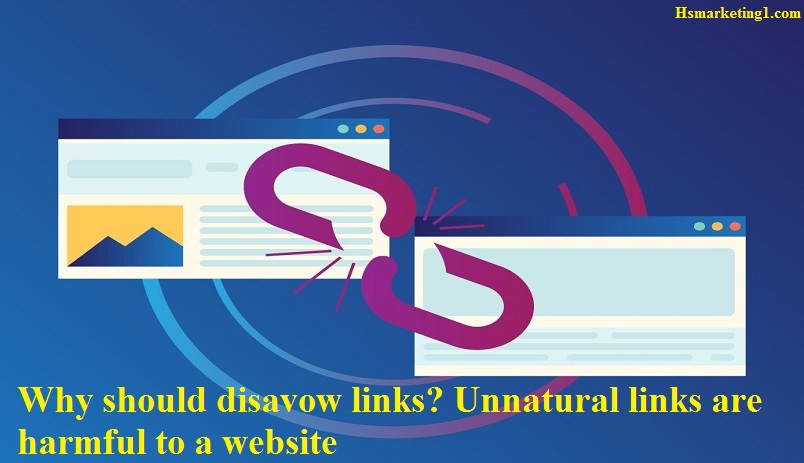
September 20, 2023, 0 Comments
Why should disavow links? Unnatural links are harmful to a website
Unnatural links have long been a concern in the world of SEO, and for good reason. Unnatural links are negative because they harm the integrity of Google’s SERPs, and the search engine manually penalizes websites. These deceptive links, often purchased or created by spammers, pose a significant threat to the integrity of Google’s search engine results pages (SERPs). They can manipulate a website’s ranking, giving it an unfair advantage over competitors that adhere to ethical SEO practices. Google has taken steps to combat this issue, with penalties and warnings issued to websites engaged in unnatural linking schemes. In this context, unnatural links refer to artificial and manipulative tactics that aim to boost a site’s visibility, but they come at a high cost in terms of credibility and trustworthiness. Here we will discuss the issue how to disavow links through Google’s disavow tool.
When we talk about “disavowing links,” it means taking action against unnatural links pointing to your site. These unnatural links are essentially manipulative links originating from other websites and can include activities like purchasing links or engaging in link exchange schemes, all of which are clear violations of Google’s guidelines. To address this issue effectively, disavowing such links becomes a necessary step to maintain your website’s credibility and ensure it adheres to Google’s quality standards.
What are backlinks?
Backlinks are like references from one website to another, showing that a webpage is valuable and important. Think of them as recommendations from other websites. When a big and premium website links to your page. It’s like a big thumbs-up to search engines, saying your content is great. This helps your page rank higher in search results. For example, when Forbes links to your website, it’s a backlink because it points to your page.
What links are beneficial for a website according to Google’s policies?
According to Google’s policies, not all links are created equal when it comes to benefiting your website’s rankings. While links do play a role in boosting rankings, the quality and nature of these links matter.
In a recent 12-month-long experiment, it was tested to see what kinds of links are most beneficial. The experiment involved manual outreach and relationship building to ensure compliance with Google’s guidelines. The results indicated that certain links are more effective:
- Relevant and High-Quality Links: Links from websites that are relevant to your niche and have a good reputation are highly valuable. These links signal to Google that your content is authoritative and trustworthy.
- Rich Anchor Text Links: Anchor text is the clickable text in a hyperlink. Links with descriptive and keyword-rich anchor text can positively impact your rankings. However, overuse of exact-match anchor text can be seen as spammy.
- One Site, Multiple Links: When the same website links to your content multiple times, it can reinforce the authority and relevance of your page.
- Link Removal Matters: If a site links to you and then removes the link, it can have a negative impact on your rankings. It’s important to maintain a healthy link profile.
While link-building is essential, it’s crucial to focus on quality over quantity. Google values links from reputable and relevant sources, and the context of the link (anchor text) also matters. Building and maintaining these kinds of links can help improve your website’s rankings in a way that aligns with Google’s policies.
What kind of links do we need to disavow?
We need to disavow only bad and unnatural links from our websites using the disavow tool.
Caution: Be Cautious When Disavowing Links
Before we dive into the world of disavowing links, it’s crucial to understand that this practice isn’t without its consequences. Disavowing links can potentially impact your website’s rankings. So, read carefully and only consider disavowing a link if you’re absolutely certain it is harming your overall link profile. If you’re uncertain and haven’t received a manual action notification regarding your links, it might be best to leave those links untouched.
When Should You Disavow Links?
Disavowing links comes into play when you have either received a manual action from Google due to unnatural links or suspect that one might be looming because of link-related violations. In such cases, your initial strategy should be to attempt to remove these problematic links from the sites linking to yours. If you can’t secure their removal on your own or through contact with the site owners, that’s when you should consider using Google’s disavow tool. This tool can help you maintain a clean and compliant link profile. Keep ensure that your website aligns with Google’s quality guidelines.
Remember, disavowing links is a powerful tool. But it should be used with care and consideration.
How to Disavow Links in Google Search Console?
If you are concerned about certain links pointing to your website and want to disavow them. Google Search Console offers a handy tool to help you with this.
Here’s a step-by-step guide on how to use the Disavow Tool :
Step 1: Access Google Search Console
First things first, ensure you have Google Analytics tracking set up on your website. This will grant you access to Google’s Search Console tool, where you can manage your website’s linking structure.
Step 2: Start Your Link Audit
Within Google Search Console, navigate to the Link Report page. Here, you can conduct a thorough link audit to identify the links you want to disavow. Click on the “Export External Links” button at the top right of the screen and choose “More Sample Links.” Save this export as a file of your preferred type.
Step 3: Use a Tool (or Do It Manually)
To identify the links you wish to disavow, you can also use external tools like Semrush Backlink Audit. This tool can help pinpoint problematic links and assist in creating a disavow list in text file format (*.txt). If you’re doing it manually, remember to follow a specific format:
- Each entry should be on a separate line.
- Each entry should start with “domain:” (without quotes).
- The filename itself doesn’t matter.
Step 4: Access the Google Disavow Tool
Now, head over to the Google Disavow Tool. Follow the prompts until you reach the dialog box where you can browse your folders and select your disavow file for uploading.
Step 5: Choose the Correct Property
If you manage multiple accounts, ensure you select the right property for your website.
Step 6: Upload Your Disavow List
Select the disavow file you’ve created and click ‘Open‘ to upload it to the Google Disavow Tool.
Step 7: Wait for Google’s Update
Google will process your disavowal request in the next day or so. Once processed, the listed domains will no longer impact your pages’ ranking.
In a nutshell, this is how you can use the Google Disavow Tool to clean up your link profile and improve your website’s standing. Remember to proceed with caution and ensure that the links you disavow are genuinely harmful to your SEO efforts.





